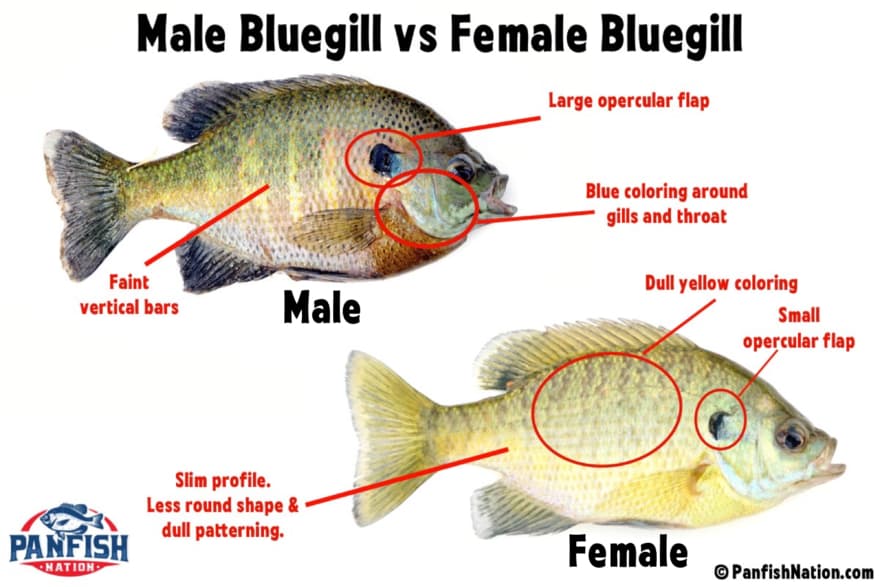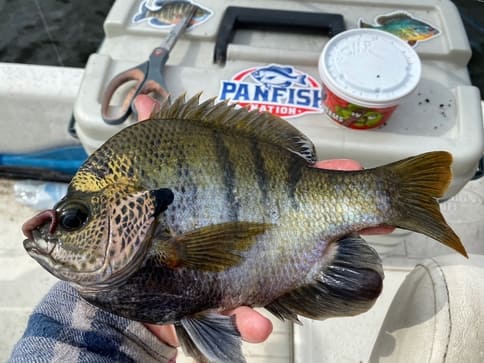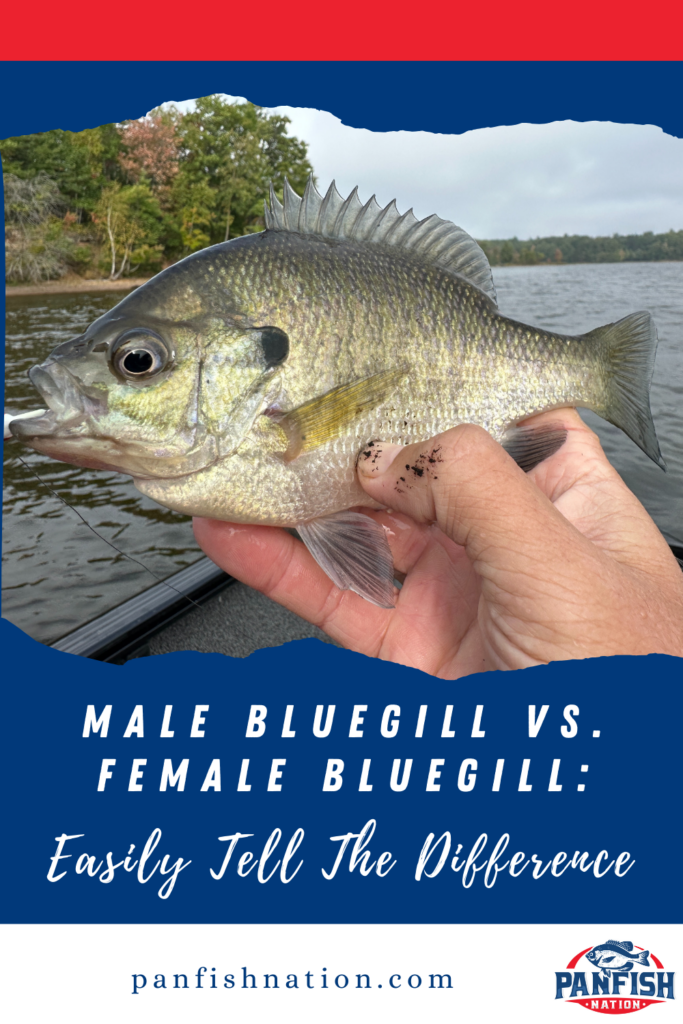Panfish have the unlucky reputation of being grouped together as one species by anglers…and Bluegills are no exception.
Take for example male bluegill vs female bluegill…many anglers are unable to tell the difference and simply refer to them all as ‘bream‘ or ‘sunfish‘.
While those terms are not wrong, it is important to know the difference.
Not only is it fun and interesting, but it can lead to better harvest decisions, and of course make you a better angler!
Table of Contents
Male Bluegill vs Female Bluegill Appearance
Bluegill are one of many species which display sexual dimorphism. This means that fully grown males and females look differently!
So you may be wondering, how can you tell male and female bluegill apart?
Mature male bluegill tend to be more brightly colored. Especially during the spawn, they are much darker and more vibrant compared to females which have fainter and lighter colors.

Male bluegills have a vibrant orange chest, a bright blue gill cover, and some even develop dark vertical bars.
Female bluegill have a dimmer orange chest and are more pale yellow in color compared to males.
Big male bluegill also tend to have a more rounded head and body shape compared to bluegill. These big round male bluegills are sometimes referred to as bull bluegill.
Another way to differentiate between male and female bluegill is by their opercular flap. The opercular flap is the black flap on the head often called “the ear of the sunfish”.
Male bluegill have a larger opercular flap and In females, this black opercular flap is short and small.
Bluegill Variations
In northern bluegills, the coloration changes depending on the season. During the summer, when bluegill are spawning, male bluegill colors darken significantly. This indicates to nearby female bluegill they are ready to spawn.
The coppernose bluegill is a different type of bluegill native to Florida and along the Atlantic Slope to North Carolina.
This subspecies is known for the dark metallic copper coloration which appears on the head of mature males. Males of this subspecies can sometimes develop very dark vertical stripes.
When mature, male and female bluegills look quite different, but if your bluegill is not fully grown, you probably will not be able to reliably tell if it is a male or female.
There are also hybrid bluegills, which is a cross between a male bluegill and a female green sunfish.
It’s no wonder why some anglers get confused! There is a lot of variety among this abundant and fun species of fish.
Which is Bigger, Male or Female Bluegill?
Male bluegill are typically larger than females of the same age. Male bluegill are naturally bigger, rounder, and stronger because they are the ones that defend their territory and protect their nest.
Big male bluegill are often known as bulls. These big bull bluegills have an enlarged hump on their head, and they are much more muscular than the average bluegill.

These bull bluegills are big and strong. They put up an incredible fight on ultralight gear.
Female bluegill produce eggs, and during the spawn, they will be wider than the males. If you catch an extra plump bluegill, it is likely a gravid female, carrying eggs.
Male Bluegill vs Female Bluegill Nesting Habits
The parental roles for bluegill are different between males and females. Male bluegills are the ones that dig the beds. The males are also the important protectors of bluegill beds. They protect the beds from threats to the eggs, like other sunfish.
The biggest male bluegills will occupy the best habitat within the nesting areas.
The parental care of these larger males is better than smaller males because they can fight for territory and protect their offspring better than the smaller males.
Related: How To Find Bluegill Beds & Time The Spawn
Should You Keep Male or Female Bluegill?
If you’re going to harvest some bluegill, it is better to release the biggest male bluegill. Some studies have shown that the population of bluegill is more dependent on the larger bull bluegill because they have the strongest parental care instincts.
It is ok to keep some of those medium size fish or even the larger females. But it is best to return the biggest males so that your population of bluegill continues strong.
Why Are Bluegills Different Colors?
Bluegill have an incredible amount of variations in their color. The best explanation for this is sexual selection and genetic differences.
Bluegill are naturally more colorful for sexual signaling! The bright colors on male bluegills are an indication to nearby females that he is mature and ready to spawn.
The spawning behavior of bluegill is very similar to many other fish species where females prefer to breed with the brightest, most vibrantly colored males.
There is a rare subspecies of bluegill, found in the Apalachicola River drainage, known as the hand-painted bluegill.
With this type of bluegill, the males have incredible red and black blotching patterns, and they look as if they were painted by an artist.
You May Also Like: Bluegill vs Crappie: Everything You Need To Know!
If you haven’t guessed yet, I love fishing and everything about it!
To learn more about why I started Panfish Nation, visit the About page and follow along on Social Media:


Download a copy of my FREE Lure Color Selection Chart & Knot Guide!
Stay up to date with fishing reports, tackle reviews, industry news, and much more! We respect your privacy, unsubscribe at any time.
Like this post? Save it on Pinterest.

Related Posts
- Sauger vs Walleye: Learn These Differences and Catch More!
- Crazy Facts About the World Record Crappie
- What Size Hooks for Smallmouth Bass? Quick Guide
- Large and in Charge-Mouth: 10 of the Best Bass Lures of All Time (And Where to Buy Them)
- Emperor of the Sun(fish): What You Need to Know About the World Record Bluegill
- Coppernose Bluegills: How They’re Different from Common Bluegill






